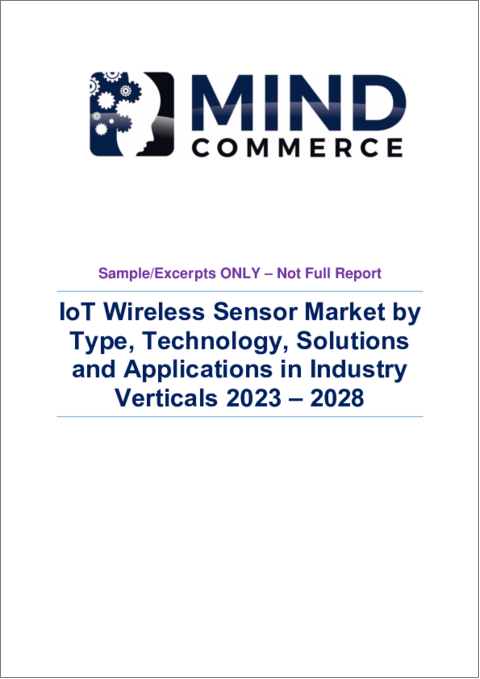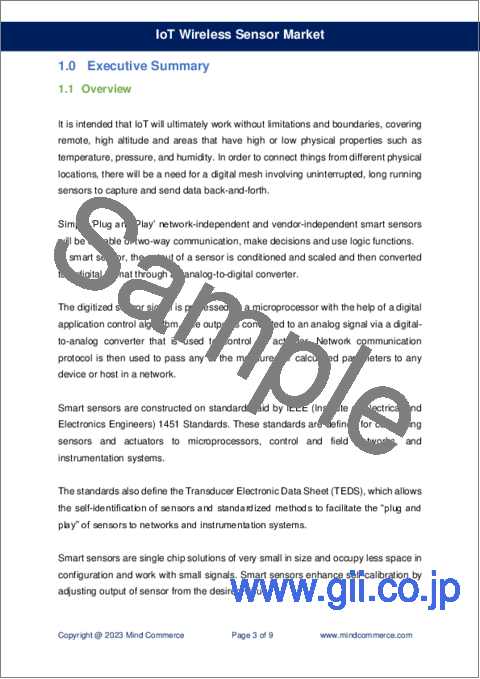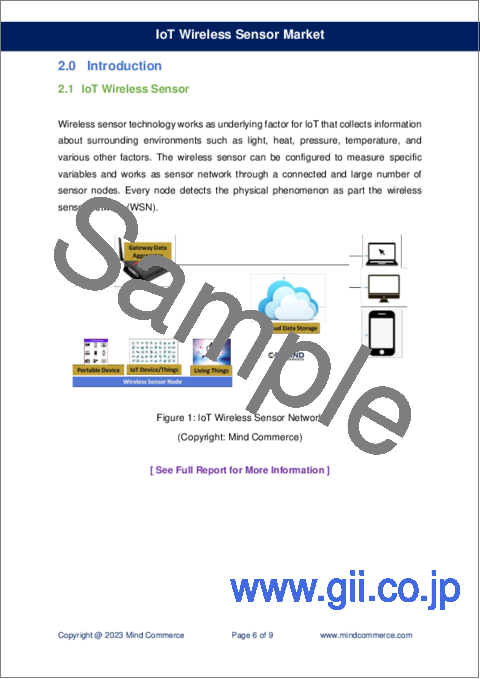|
|
市場調査レポート
商品コード
1272856
IoTワイヤレスセンサー市場 (2023~2028年):タイプ・技術・ソリューション・用途・産業別IoT Wireless Sensor Market by Type, Technology, Solutions and Applications in Industry Verticals 2023 - 2028 |
||||||
| IoTワイヤレスセンサー市場 (2023~2028年):タイプ・技術・ソリューション・用途・産業別 |
|
出版日: 2023年05月16日
発行: Mind Commerce
ページ情報: 英文 115 Pages
納期: 即日から翌営業日
|
- 全表示
- 概要
- 図表
- 目次
IoTワイヤレスセンサーの市場規模は、2028年に292億米ドルの規模を示すと予測されています。また、数量では、2028年に3億2,450万ユニットの規模を示す見通しです。用途別では、産業用IoTが93%超のシェアを示す見通しです。地域別では、北米が市場をリードし、アジア太平洋がこれに続く見通しです。
概要
このIoTワイヤレスセンサーのレポートは、IoTに関連するセンサー、プロトコル、センサーデータを分析しています。本レポートでは、インフラのIoTセンサーコンポーネントとセンサーネットワークに依存するアプリケーションを評価しています。
センサーソリューション企業やセンサー企業の製品・サービスなど競合情勢を評価しています。また、2023年から2028年までのIoTセンサー市場の市場予測も行っています。また、利害関係者に対する具体的な提言も行っています。
レポート所見の抜粋
- スマートセンサーはIoTの実質的な成長促進要因となる
- IoTワイヤレスセンサー市場は2028年までに292億米ドルに達する
- 産業用IoTが全アプリケーション分野の93%以上を占めるようになります
- 北米が市場をリードし、アジア太平洋地域がこれに続く
- 2028年、IoTワイヤレスセンサーは3億2,450万ユニットに達します
- 企業向けが市場の36%、産業向けが91%を牽引する
センサーは、ある物体と他の物体や環境との物理的・論理的関係の変化を検出するために、ICTで使用されます。物理的な変化には、温度、光、水分、圧力、音、動きなどがあります。論理的な変化には、電子的に追跡可能なエンティティ、場所、および/またはアプリケーションやサービスの使用などの活動の有無が含まれます。モノのインターネット(IoT)の文脈では、物理的変化と論理的変化は同じように重要です。
物理的環境と論理的環境の両方から得られるセンサーデータの融合は、ビッグデータ技術の利用を含む強固なデータ管理の必要性を引き起こすと我々は考えています。また、物理的なデータと論理的なデータの組み合わせは、より高度なセキュリティとプライバシー管理ツールの必要性を促進すると考えています。いずれの場合も、データ管理とセキュリティ/プライバシー管理の両方の目的で、IoTメディエーションが強く求められています。
当レポートでは、IoTワイヤレスセンサーの市場を調査し、市場および技術の概要、市場機会と課題、技術および用途の分析、市場規模の推移・予測、各種区分・地域別の内訳、主要企業の分析などをまとめています。
目次
第1章 エグゼクティブサマリー
第2章 イントロダクション
- IoTワイヤレスセンサー
- スマートセンサーとインテリジェントエンドポイント
- IoTワイヤレスセンサーネットワークアーキテクチャ
- IoTワイヤレスセンサー市場の機会
- IoTワイヤレスセンサー市場の課題
- IoTワイヤレスセンサーのバリューチェーン分析
- IoTワイヤレスセンサーのビジネスモデル
- COVID-19の影響分析
第3章 技術および用途の分析
- ワイヤレスセンサーネットワーク
- センサーノード
- WSNトポロジー
- 用途と課題
- 仮想/ソフトセンサー・マルチセンシング・センサーフュージョン
- IoTにおけるWSNとセンサーフュージョンの役割
- ワイヤレスセンサータイプの分析
- 圧力センサー
- 温度・湿度センサー
- 化学センサー・ガスセンサー
- 位置/動作センサー・近接センサー
- レベルセンサー・流量センサー
- バイオセンサー
- 監視およびセキュリティセンサー
- 使用されるIoTプロトコル
- Bluetooth・Bluetooth Smart
- WiFi・WLAN/6LoWPAN
- Zigbee・RF4CE
- RFID
- WirelessHART
- EnOcean
- Z-Wave
- Insteon
- Digital Living Network Alliance
- Thread
- 各産業における潜在的用途
- 自動車・輸送
- ヘルスケア・医療
- スマート衣料品・CE製品
- 航空宇宙・防衛
- エネルギー・電力
- スポーツ・フィットネス
- 食品・飲料
- スマートホーム・ワークプレイス
- 農業
- 製造
- インダストリアルIoTとコンシューマーIoTの役割
- センサーデータ管理とIoTセキュリティ/プライバシー
- センサーデータ管理
- センサー・IoTサービス・インフラ仲介
- センサーアナリティクス
- データ視覚化
- データインフラの問題
第4章 IoTセンサー企業の分析
- ABB
- Phoenix Energy Technologies
- Ambiq Micro
- Sensors Inc
- Aruba Networks
- Microchip Technology(Atmel Corporation)
- Advantech B+B SmartWorx
- BAE Systems Plc
- Baumer
- Bosch Sensortec GmbH
- Carlo Gavazzi Automation SPA
- Chevron Corporation
- Digi International
- Analog Devices(Dust Networks & Linear Technology Corporation)
- Eaton Corporation
- Emerson Electric Co.(Emerson Network Power)
- Endress+Hauser Group Services AG
- ON Semiconductor(Fairchild Semiconductors International)
- Fargo Controls
- Gastronics Inc
- General Electric
- Hans TURCK GmbH & Co. KG
- HENSOLDT
- Honeywell International
- ifm electronics
- Interlogix Inc.
- Raytheon Technologies Corporation(United Technologies Corporation)
- Johnson Controls International plc
- LeddarTech Inc.
- Parker Hannifin Corp(LORD, MicroStrain Sensing Systems)
- Monnit Corporation
- Nanjing IoT Sensor Technology Co., Ltd.
- NXP Semiconductors(Freescale Semiconductors Inc)
- NYCE Sensors Inc.
- OMRON Corporation
- Open Sensors
- Pasco Scientific
- Pepperl+Fuchs
- Phoenix Sensors LLC
- Mesa Laboratories Inc(Point Six Wireless)
- Qualcomm Inc.(CSR)
- Renesas Electronics
- Rockwell Automation Inc.
- Schneider Electric SE
- SCHUNK
- Sensata Technologies
- SICK AG
- Siemens AG
- Silicon Laboratories Inc.
- STMicroelectronics
- Texas Instruments Inc.
- Worldsensing
- Wovyn LLC
- Yokogawa Electric Corporation
第5章 市場分析・予測
- IoTワイヤレスセンサー市場の予測
- 世界のIoTワイヤレスセンサー市場
- センサータイプ別
- 技術別
- 用途別
- 展開別
- 産業別
- 地域別
- IoTワイヤレスセンサーの出荷数
- 世界のIoTワイヤレスセンサーの出荷数
- センサータイプ別
- 技術別
- 用途別
- 展開別
- 産業別
- 地域別
第6章 総論・提言
Figures
- Figure 1: IoT Wireless Sensor Network
- Figure 2: Fog Computing in IoT
- Figure 3: Intelligent Endpoint Data in Fog Computing
- Figure 4: Traditional Sensor Elements
- Figure 5: Elements of Smart Sensor
- Figure 6: Smart Sensor Model
- Figure 7: Functional Partitioning in Smart Sensor
- Figure 8: IoT WSN Business Model
- Figure 9: Sensor Node Components
- Figure 10: Wireless Sensor Network Topologies
- Figure 11: IoT Infrastructure, Platform, and Software Mediation
- Figure 12: Phase One: Limited IoT Data Sharing without Formalized Mediation
- Figure 13: Phase Two: IoT Data Sharing between Limited Industries
- Figure 14: Phase Three: Broadly shared IoT Data across Industries and between Competitors
- Figure 15: Sensor and Intelligent Endpoint Analytics
- Figure 16: Adaptive Energy Management Solution
- Figure 17: Global IoT Wireless Sensor Market 2023 - 2028
- Figure 18: Global IoT Wireless Sensor Unit Shipment 2023 - 2028
Tables
- Table 1: Transducer Electronic Data Sheets Elements
- Table 2: Global IoT Wireless Sensor Market by Sensor Type 2023 - 2028
- Table 3: Global IoT Wireless Sensor Market by Technology 2023 - 2028
- Table 4: Global IoT Wireless Sensor Market by Application 2023 - 2028
- Table 5: Global IoT Wireless Sensor Market by Deployment 2023 - 2028
- Table 6: Global IoT Wireless Sensor Market by Industry Vertical 2023 - 2028
- Table 7: Global IoT Wireless Sensor Market by Region 2023 - 2028
- Table 8: North America IoT Wireless Sensor Market by Country 2023 - 2028
- Table 9: APAC IoT Wireless Sensor Market by Country 2023 - 2028
- Table 10: Europe IoT Wireless Sensor Market by Country 2023 - 2028
- Table 11: Latin America IoT Wireless Sensor Market by Country 2023 - 2028
- Table 12: MEA IoT Wireless Sensor Market by Country 2023 - 2028
- Table 13: Global IoT Wireless Sensor Unit Shipment by Sensor Type 2023 - 2028
- Table 14: Global IoT Wireless Sensor Unit Shipment by Technology 2023 - 2028
- Table 15: Global IoT Wireless Sensor Unit Shipment by Application 2023 - 2028
- Table 16: Global IoT Wireless Sensor Unit Shipment by Deployment 2023 - 2028
- Table 17: Global IoT Wireless Sensor Unit Shipment by Industry Vertical 2023 - 2028
- Table 18: Global IoT Wireless Sensor Unit Shipment by Region 2023 - 2028
- Table 19: North America IoT Wireless Sensor Unit Shipment by Country 2023 - 2028
- Table 20: APAC IoT Wireless Sensor Unit Shipment by Country 2023 - 2028
- Table 21: Europe IoT Wireless Sensor Unit Shipment by Country 2023 - 2028
- Table 22: Latin America IoT Wireless Sensor Unit Shipment by Country 2023 - 2028
- Table 23: MEA IoT Wireless Sensor Unit Shipment by Country 2023 - 2028
Overview:
This IoT wireless sensor report analyzes sensors, protocols, and sensor data in relation to IoT. The report evaluates infrastructure IoT sensor components and applications that rely upon sensor networks.
The report assesses the competitive landscape including sensor solution companies as well as products and services of select sensor companies. The report also provides market forecasts for the IoT sensors market for 2023 through 2028. The report also provides specific recommendations for stakeholders.
Select Report Findings:
- Smart sensors will be a substantial growth enabler for IoT
- IoT wireless sensor market will reach USD $29.2 billion by 2028
- Industrial IoT will represent more than 93% of all application areas
- North America will lead the market followed closely by Asia Pacific
- IoT wireless sensor shipments will reach 324.5 million units by 2028
- Enterprise and industrial will drive 36% and 91% of the market respectively
Sensors are used in ICT for the detection of changes in the physical and/or logical relationship of one object to another(s) and/or the environment. Physical changes may include temperature, light, moisture, pressure, sound, and motion. Logical changes include the presence/absence of an electronically traceable entity, location, and/or activity such as usage of an application or service. Within an Internet of things (IoT) context, physical and logical changes are equally important.
We believe that the merging of sensor data from both physical and logical environments will trigger the need for robust data management including the use of big data technologies. We also see the combination of physical and logical data precipitating the need for more advanced security and privacy management tools. In both cases, there is a strong need for IoT Mediation for both data management and security/privacy management purposes.
Companies in Report:
|
|
Table of Contents
1.0. Executive Summary
2.0. Introduction
- 2.1. IoT Wireless Sensor
- 2.1.1. Critical Capabilities
- 2.1.2. Sensor Functionalities in IoT
- 2.2. Smart Sensors and Intelligent Endpoints
- 2.2.1. Intelligence at the Edge of the Network
- 2.2.2. Key Differentiations of Smart Sensors
- 2.3. IoT Wireless Sensor Network Architecture
- 2.3.1. Conventional Sensor Architecture
- 2.3.2. Smart Sensor Architecture
- 2.3.2.1. Transducer Electronic Data Sheets
- 2.3.2.2. Smart Transducer Interface Module and Network Capable Application Processor
- 2.4. IoT Wireless Sensor Market Opportunity
- 2.4.1. Opportunity for Sensor Manufacturers
- 2.4.2. Demand for Short Range Sensors to Realize Brisk Growth
- 2.4.3. Opportunity for Systems-on-Chip Fabricators
- 2.4.4. Use of IPV6 brings New Opportunities from Massive Connectivity
- 2.5. IoT Wireless Sensor Market Challenge
- 2.6. IoT Wireless Sensor Value Chain Analysis
- 2.6.1. Sensor Manufacturer
- 2.6.2. Device Manufacturer
- 2.6.3. Industrial Service Providers
- 2.6.4. Sensor Analytics Providers
- 2.6.5. IoT Service Providers
- 2.6.6. Enterprise and Government
- 2.7. IoT Wireless Sensor Business Model
- 2.7.1. OEM Model
- 2.7.2. Aftermarket Model
- 2.7.3. Sensor Analytics
- 2.8. Covid-19 Impact Analytics
3.0. Technology and Application Analysis
- 3.1. Wireless Sensor Networks
- 3.1.1. Sensor Nodes
- 3.1.2. WSN Topologies
- 3.1.3. Applications and Challenges
- 3.2. Virtual / Soft Sensors, Multi-sensing, and Sensor Fusion
- 3.3. Role of WSN and Sensor Fusion in IoT
- 3.4. Wireless Sensor Type Analysis
- 3.4.1. Pressure Sensors
- 3.4.2. Temperature and Humidity Sensors
- 3.4.3. Chemical and Gas Sensors
- 3.4.4. Position/Motion and Proximity Sensors
- 3.4.5. Level and Flow Sensors
- 3.4.6. Biosensors
- 3.4.7. Surveillance and Security Sensors
- 3.5. IoT Protocol Used
- 3.5.1. Bluetooth and Bluetooth Smart
- 3.5.2. WiFi and WLAN/6LoWPAN
- 3.5.3. Zigbee and RF4CE
- 3.5.4. RFID
- 3.5.5. WirelessHART
- 3.5.6. EnOcean
- 3.5.7. Z-Wave
- 3.5.8. Insteon
- 3.5.9. Digital Living Network Alliance
- 3.5.10. Thread
- 3.6. High Potential Application in Industry Vertical
- 3.6.1. Automotive and Transportation
- 3.6.2. Healthcare and Medical
- 3.6.3. Smart Clothing and Consumer Electronics
- 3.6.4. Aerospace and Defense
- 3.6.5. Energy and Power
- 3.6.6. Sports and Fitness
- 3.6.7. Food and Beverage
- 3.6.8. Smart Home and Workplace
- 3.6.9. Agriculture
- 3.6.10. Manufacturing
- 3.7. Role of Industrial IoT and Consumer IoT
- 3.8. Sensor Data Management and IoT Security/Privacy
- 3.8.1. Sensor Data Management
- 3.8.2. Sensors and IoT Services and Infrastructure Mediation
- 3.9. Sensor Analytics
- 3.9.1. Data Visualization
- 3.9.2. Data Infrastructure Issues
4.0. IoT Sensor Company Analysis
- 4.1. ABB
- 4.2. Phoenix Energy Technologies
- 4.3. Ambiq Micro
- 4.4. Sensors Inc
- 4.5. Aruba Networks
- 4.6. Microchip Technology (Atmel Corporation)
- 4.7. Advantech B+B SmartWorx
- 4.8. BAE Systems Plc
- 4.9. Baumer
- 4.10. Bosch Sensortec GmbH
- 4.11. Carlo Gavazzi Automation SPA
- 4.12. Chevron Corporation
- 4.13. Digi International
- 4.14. Analog Devices (Dust Networks & Linear Technology Corporation)
- 4.15. Eaton Corporation
- 4.16. Emerson Electric Co. (Emerson Network Power)
- 4.17. Endress+Hauser Group Services AG
- 4.18. ON Semiconductor (Fairchild Semiconductors International)
- 4.19. Fargo Controls
- 4.20. Gastronics Inc
- 4.21. General Electric
- 4.22. Hans TURCK GmbH & Co. KG
- 4.23. HENSOLDT
- 4.24. Honeywell International
- 4.25. ifm electronics
- 4.26. Interlogix Inc.
- 4.27. Raytheon Technologies Corporation (United Technologies Corporation)
- 4.28. Johnson Controls International plc
- 4.29. LeddarTech Inc.
- 4.30. Parker Hannifin Corp (LORD, MicroStrain Sensing Systems)
- 4.31. Monnit Corporation
- 4.32. Nanjing IoT Sensor Technology Co., Ltd.
- 4.33. NXP Semiconductors (Freescale Semiconductors Inc)
- 4.34. NYCE Sensors Inc.
- 4.35. OMRON Corporation
- 4.36. Open Sensors
- 4.37. Pasco Scientific
- 4.38. Pepperl+Fuchs
- 4.39. Phoenix Sensors LLC
- 4.40. Mesa Laboratories Inc (Point Six Wireless)
- 4.41. Qualcomm Inc. (CSR)
- 4.42. Renesas Electronics
- 4.43. Rockwell Automation Inc.
- 4.44. Schneider Electric SE
- 4.45. SCHUNK
- 4.46. Sensata Technologies
- 4.47. SICK AG
- 4.48. Siemens AG
- 4.49. Silicon Laboratories Inc.
- 4.50. STMicroelectronics
- 4.51. Texas Instruments Inc.
- 4.52. Worldsensing
- 4.53. Wovyn LLC
- 4.54. Yokogawa Electric Corporation
5.0. Market Analysis and Forecasts 2023-2028
- 5.1. IoT Wireless Sensor Market 2023-2028
- 5.1.1. Global IoT Wireless Sensor Market
- 5.1.2. Global IoT Wireless Sensor Market by Sensor Type
- 5.1.3. Global IoT Wireless Sensor Market by Technology
- 5.1.4. Global IoT Wireless Sensor Market by Application
- 5.1.5. Global IoT Wireless Sensor Market by Deployment
- 5.1.6. Global IoT Wireless Sensor Market by Industry Vertical
- 5.1.7. Global IoT Wireless Sensor Market by Region
- 5.1.7.1. North America IoT Wireless Sensor Market by Country
- 5.1.7.2. APAC IoT Wireless Sensor Market by Country
- 5.1.7.3. Europe IoT Wireless Sensor Market by Country
- 5.1.7.4. Latin America IoT Wireless Sensor Market by Country
- 5.1.7.5. MEA IoT Wireless Sensor Market by Country
- 5.2. IoT Wireless Sensor Unit Shipment 2023-2028
- 5.2.1. Global IoT Wireless Sensor Unit Shipment
- 5.2.2. Global IoT Wireless Sensor Unit Shipment by Sensor Type
- 5.2.3. Global IoT Wireless Sensor Unit Shipment by Technology
- 5.2.4. Global IoT Wireless Sensor Unit Shipment by Application
- 5.2.5. Global IoT Wireless Sensor Unit Shipment by Deployment
- 5.2.6. Global IoT Wireless Sensor Unit Shipment by Industry Vertical
- 5.2.7. Global IoT Wireless Sensor Unit Shipment by Region
- 5.2.7.1. North America IoT Wireless Sensor Unit Shipment by Country
- 5.2.7.2. APAC IoT Wireless Sensor Unit Shipment by Country
- 5.2.7.3. Europe IoT Wireless Sensor Unit Shipment by Country
- 5.2.7.4. Latin America IoT Wireless Sensor Unit Shipment by Country
- 5.2.7.5. MEA IoT Wireless Sensor Unit Shipment by Country




